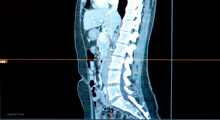A new search tool developed by researchers at Microsoft indexes medical images of the human body, rather than the Web. On CT scans, it automatically finds organs and other structures, to help doctors navigate in and work with 3D medical imagery.
CT scans use X-rays to capture many slices through the body that can be combined to create a 3-D representation. This is a powerful tool for diagnosis, but it's far from easy to navigate, says Antonio Criminisi
When a scan is loaded into Criminisi's software, the program indexes the data and lists the organs it finds at the side of the screen, creating a table of hyperlinks for the body. A user can click on, say, the word "heart" and be presented with a clear view of the organ without having to navigate through the imagery manually.
Read more..., who leads a group at Microsoft Research Cambridge, U.K., that is attempting to change that. "It is very difficult even for someone very trained to get to the place they need to be to examine the source of a problem, he says.
CT scans use X-rays to capture many slices through the body that can be combined to create a 3-D representation. This is a powerful tool for diagnosis, but it's far from easy to navigate, says Antonio Criminisi
When a scan is loaded into Criminisi's software, the program indexes the data and lists the organs it finds at the side of the screen, creating a table of hyperlinks for the body. A user can click on, say, the word "heart" and be presented with a clear view of the organ without having to navigate through the imagery manually.
Read more..., who leads a group at Microsoft Research Cambridge, U.K., that is attempting to change that. "It is very difficult even for someone very trained to get to the place they need to be to examine the source of a problem, he says.


0 comments:
Post a Comment